27 September 2006
26 September 2006
Web site finished!

Hurrah. I have finally finished my own photo Web site. Well, nothing is ever finished when it comes to me designing a Web site -- let's say its about 95% finished. I just need to come up with a decent links page for recommended Web pages related to photography in Japan. Any ideas? Yikes.
I have put up my last three photo projects, Asuka, Takayama/Shirakawago and Himeji Castle (all taken with the Nikon D80) as well as some older photo sets (taken with the Canon G3 from up to two years ago). You can see them here:
http://www.an-fi.com/photo
I came up with the idea of a photo site two years ago and I finally decided to do it, because it has been a real hassle to upload pictures for this blog. Often I have had to upload the same image a half-dozen times until I was satisfied with the size and layout. This blog is just taking too much time with all these pictures. Now with a photo site I can just make an easy link from here to there. I hope that means I can spend more time writing, too.
I don't know if that is a promise or a threat.
Or a lie.
Posted by
an-fi (Angel Figueroa)
at
7:27 PM
0
comments
![]()
Labels: an-fi gallery
25 September 2006
Yoshimi
My workplace is right beside the Osaka Kabuki theatre, in Namba. There are new streamers and flags hanging from the building, signaling the start of another run of performances. This time the flags are especially colorful. I have no idea who "Yoshimi" is.
Posted by
an-fi (Angel Figueroa)
at
11:22 PM
0
comments
![]()
Labels: artsy
24 September 2006
Sekonic Reunited / Himeji Castle
Up to now there has been a common thread of frustration while taking pictures: blinking highlights.
I'd take a picture, look at the LCD panel, and see white areas flashing back at me, a sign of washed out whites due to over-exposure. It was really annoying: almost every shot I took in Shirakawago was over-exposed. As a rule, I like to shoot at minus one-third stop anyway, but everything seemed to be at least two-thirds over-exposed. I wanted to blame the camera because whenever I composed a shot I was always trying to meter off something close to middle-gray. And yet the results were always off. Sometimes way off. It might take six or seven shots of the same thing while fiddling with exposure settings before getting a decent shot. But I am hesitant to blame the camera.
I was thinking about this while on the train home from work on Thursday. On Saturday (yesterday) I wanted to go somewhere to photograph, and was considering the options. It had to be a short day trip, because I have a gig on Sunday and I should be back home by Saturday evening for an early night's sleep. Wherever I was going to go, I had to do something about that trend of flashing highlights. Then I remembered that I had some old photo gear in the closet that I hadn't touched in ages -- since the F3HP days, in fact -- maybe somewhere in there was my old trusty lightmeter.
The first thing I did when I got home was rummage through my closet. I soon found it. An old Sekonic, a bit banged up but still working. I am sure I hadn't used it in seven or eight years, not since I lived in Korea. 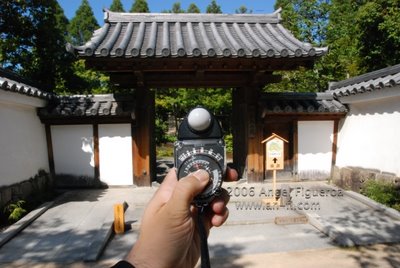 Never mind the washed-out wall on the right.
Never mind the washed-out wall on the right.
I decided to go to Himeji Castle, since I had never been there before and it was only an hour by express train from Osaka. What a day it turned out to be. The lightmeter performed admirably. I shot entirely on manual, adjusting the settings according to whatever the lightmeter said. A beautiful blue sky, white plaster walls, and direct sunlight was an excellent challenge, but I am very happy with the shots. I have my lightmeter to thank for that.
Himeji Castle is another World Heritage Site (there seem to be many in Japan!) that is well worth a visit. 
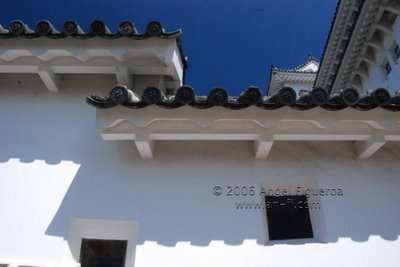

The nearby Kokuen garden was built in 1992 to commemorate the one hundredth anniversary of the establishment of Himeji municipality. It is a beautiful setting of trees, ponds, streams, goldfish and trees. 


added 26 Sept.:
Visit my online photo galleries for more shots of Himeji Castle and Kokuen Garden.
Posted by
an-fi (Angel Figueroa)
at
10:49 PM
0
comments
![]()
Labels: an-fi gallery, buildings, castles, gardens, Himeji, Japan, sky, summer, traditional
21 September 2006
20 September 2006
Patterns up above
Take a note: buildings.
As dull as it might originally sound, a photo project on Osaka buildings might be a good idea. The idea would be to take minimalist pictures and use their surface patterns as the main elements in the pictures. The idea came to me when looking upwards this afternoon, while walking around Namba during lunch time.
I have heard people say Osaka is boring for architecture. I don't agree. You only have to look around. Or I should say, look up...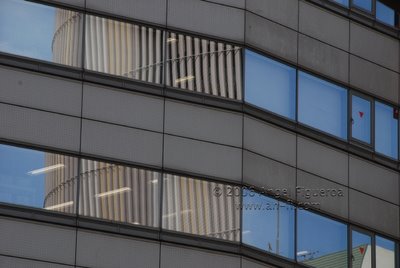
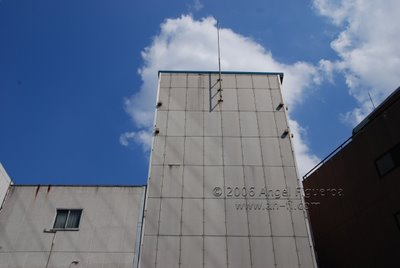
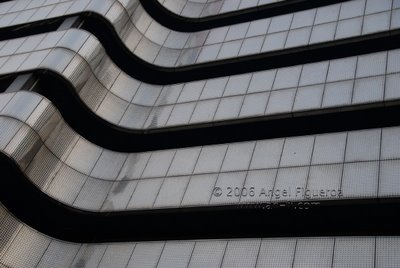

 \
\
19 September 2006
Takayama & Shirakawago, Gifu
R and I decided on Takayama and Shirakawago for our long-weekend trip. If there was one thing I got out of it, it was a reminder that the air in Osaka is dreadful. The pleasant remoteness of Takayama, and moreso Shirakawago, was made very apparent by the six hour journey by train into the mountains in the heart of Gifu, and it was so nice to breathe clean air again.  View from the train
View from the train
We took a train from Nagoya (after arriving from Osaka) because we didn't know there was a direct train via Maibara that takes only four hours. Oh well. The 2 hour, 20 minute ride from Nagoya to Takayama went by quickly because of the fine views of the Hida river and the surrounding mountains.
Takayama Takayama is a small town dubbed "little Kyoto" for its similarities including picturesque canals, temples and old wooden houses from the Edo era. Frankly I find it more appealing than Kyoto. It must be cold in the winter, with high snow banks and wet snowfalls, but a trip there at any time of the year is sure to be rewarding. We arrived on a cloudy day, and it soon began to rain, but that didn't dampen our spirits. It's easy to walk around the main part of the town; everything is close to the train station. Particularly appealing is the three or four streets that make up the town's main attraction: Sanmachi suji, a neighbourhood of old wooden houses dating from the 18th century and earlier, when Takayama thrived as a city of wealthy merchants. In these streets you can find craft shops, tea and coffee shops, sake breweries, old homes, souvenir shops and restaurants.
Takayama is a small town dubbed "little Kyoto" for its similarities including picturesque canals, temples and old wooden houses from the Edo era. Frankly I find it more appealing than Kyoto. It must be cold in the winter, with high snow banks and wet snowfalls, but a trip there at any time of the year is sure to be rewarding. We arrived on a cloudy day, and it soon began to rain, but that didn't dampen our spirits. It's easy to walk around the main part of the town; everything is close to the train station. Particularly appealing is the three or four streets that make up the town's main attraction: Sanmachi suji, a neighbourhood of old wooden houses dating from the 18th century and earlier, when Takayama thrived as a city of wealthy merchants. In these streets you can find craft shops, tea and coffee shops, sake breweries, old homes, souvenir shops and restaurants.  Sanmachi suji
Sanmachi suji Other sightseeing spots in Takayama are: Takayama Jinja, a historic government building that used to house visiting officials from Edo; Takayama -shi Kyodo-kan, the local history museum; Hirata kinen-kan, the Folk Art Museum; a number of heritage houses; Hachimangu Shrine; Teramachi, a temple district; and two "morning markets" along the Miyagawa river. Also noteworthy is the surrounding rural area, offering a glimpse into rural Japan.
Other sightseeing spots in Takayama are: Takayama Jinja, a historic government building that used to house visiting officials from Edo; Takayama -shi Kyodo-kan, the local history museum; Hirata kinen-kan, the Folk Art Museum; a number of heritage houses; Hachimangu Shrine; Teramachi, a temple district; and two "morning markets" along the Miyagawa river. Also noteworthy is the surrounding rural area, offering a glimpse into rural Japan. The Local History Museum: well worth a visit
The Local History Museum: well worth a visit
Shirakawago Shirakawago
Shirakawago From Takayama, Shirakawago is two hours away by bus. It is famous for its giant, thatched-roof houses and was made a World Heritage Site in 1995. I didn't know anything about the place, but became very interested in the way the massive houses were constructed and maintained. Called "gasho-zukuri" because their steep, thatched roofs look like praying hands, they are characterized by a multi-storey attic that was used to raise silkworms.
From Takayama, Shirakawago is two hours away by bus. It is famous for its giant, thatched-roof houses and was made a World Heritage Site in 1995. I didn't know anything about the place, but became very interested in the way the massive houses were constructed and maintained. Called "gasho-zukuri" because their steep, thatched roofs look like praying hands, they are characterized by a multi-storey attic that was used to raise silkworms. 
Gasho style houses are made entirely of wood and grass, with the first floor being built by professional carpenters while the roof is built by villagers who band together in a co-operative, or labour-sharing union. The roofing is done by 100-200 villagers, young and old, and takes one full day. They used to be replaced every 40-50 years, but due to changes in materials re-roofing is done approximately every 30 years now. Pampas grass, which is grown locally, is currently used for the thatched roofs. In the past, kariyasu was preferred since it was easier to grow. Structurally, gasho houses are very sound, with carefully selected timber used for the house's frame. The roof and the first floor are actually separate, so when a strong wind blows, the bottom part of the triangular roof frame moves and disperses the force. The roof frame itself is made with tightly woven branches of the mansaku tree, making the roof flexible.
Structurally, gasho houses are very sound, with carefully selected timber used for the house's frame. The roof and the first floor are actually separate, so when a strong wind blows, the bottom part of the triangular roof frame moves and disperses the force. The roof frame itself is made with tightly woven branches of the mansaku tree, making the roof flexible.
You can mill about the town and visit some of it's more famous gahso houses to see what they look like inside. Some of them have restaurants serving the local specialty of buckwheat noodles, while others have been made into craftshops and souvenirs stores. View from the hill overlooking Shirakawago
View from the hill overlooking Shirakawago
Photographically, Shirakawago is stunning. There is a small hill to the north of the town from which there is a wonderful view. On the southern side there are terraced rice fields. If you look at the town map, which is availalble at the tourist information centre, there are some pointers for taking great pictures from certain vantage points. Heritage Museum
Heritage Museum
I highly recommend the Heritage Museum, a collection of two dozen gahso style houses that were relocated and rebuilt in this open-air museum at the entrance of the town, just opposite the bus station. Each Gasho house bears the name of the family that once owned it, and one can get a real sense of how people used to live. Many of these houses were relocated here because the construction of the nearby dam on the Sho river forced many communities to be abandoned. Other houses, particularly from a village called Kazura, were moved here after the town's aging residents decided on an exodus because life in the mountains during the harsh winters had become too difficult. Indeed, if you spend some time in the detailed galleries (located in the attics of some of the houses), you can get a real sense of the unique lifestyle --and hardships -- that characterized the Japan alps in the early 20th century and earlier.  Southern part of Shirakawago
Southern part of Shirakawago
Shirakawago is one of those rare destinations that has a totally different face depending on the season in which you visit. R and I arrived shortly before the rice harvest. The rice fields were full and yellow. Spring and summer must also be special, for the cherry blossoms in April and the rice planting in June. Of course the mounds of snow in winter have their charm, too.
Our trip to the heart of Gifu was very rewarding. Takayama is a nice little town, great for a weekend escape from your standard Japanese metropolis, while Shirakawago was a picturesque, educational, and photographic getaway like none other I had visited in Japan. Best of all, there was much-needed clean air throughout.
added 26 Sept.:
For more pictures of Takayama and Shirakawago, visit my photo galleries at www.an-fi.com:
Takayama pictures:
http://www.an-fi.com/photo/v16/Takayama/index.html
Shirakawago pictures:
http://www.an-fi.com/photo/v16/Shirakawago/index.html
Posted by
an-fi (Angel Figueroa)
at
3:43 AM
3
comments
![]()
Labels: an-fi gallery, buildings, Chubu, Japan, landscapes, nature, rural, sky, summer, traditional, travelogue, water
13 September 2006
Kyoto
Two days after I bought the D80 I went out with it to take its first real test run. (I had bought the camera on Friday night, and had a deejaying gig on Saturday night, so except for a quick hour of snapping around my neighbourhood on Saturday morning --the result of which is here-- I hadn't really done anything with it.) I needed some kind of excursion. Now why wouldn't I choose Kyoto, just an hour away?
Eleven shots: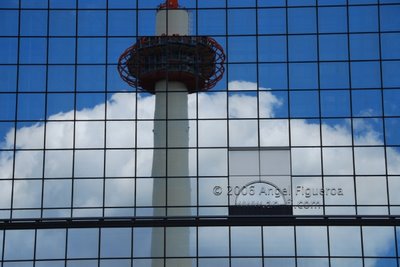










Posted by
an-fi (Angel Figueroa)
at
8:13 PM
0
comments
![]()
Labels: buildings, gardens, Japan, Kansai, Kyoto, nature, shrines/temples, summer, traditional, water
10 September 2006
Asuka Wine, Boulders & Rice Fields
I didn't know wine was made so close to Osaka! I discovered that yesterday while cycling down a country road in Asuka, a historical national park southeast of Osaka city. I had decided to go to Asuka to test my camera. It seemed like an inviting place -- an easy day-trip from Osaka -- with plenty of things to photograph. I had first heard about Asuka from R and, after asking my students about it (their descriptions of the area were convincingly positive), I was keen to get there by mid-morning.
Most Osakans have visited the park on a school field trip. Asuka, an ancient administrative capital, is famous for its array of mysterious boulders strewn about the area. Untouched for more than a thousand years, no one really knows how they managed to get there. A half-dozen hamlets dot the area, flanked on all sides by rice fields. Here are there you can bump into one of these boulders, some colourfully named: Tortoise Stone, Two-Faced Stone, Devil's Chopping Board. Other boulders serve as what appear to be ingeniously-made tombs, some of them so huge it baffles the imagination how they could have been carried and joined together almost seamlessly. 
Click on the photographs to see in a larger size.
Note: Safari seems to have a bug; clicking on a picture might give you a page of garbled text instead of a bigger picture. Firefox works fine, however, so switch to Firefox if you want to see the larger pictures.
As I was about to discover, these boulders and tombs are not the only part of Asuka's appeal. Whether you are a budding photographer, a hiker, a history buff or just a tired city dweller in need of some fresh air and greenery, Asuka is well worth a visit.
For some information on historical Asuka visit here.
R and I arrived at Kintetsu Asuka station after a 50 minute ride from Tennoji. Immediately on your left as you exit there is a visitor's information center. They had a good map of the area in English. We rented bicycles from the shop next door and got on our way. I had hesitated before deciding to rent a bicycle (at 1000 yen each for the day) but was soon glad that I had. Asuka isn't too huge for a walkabout, but having a bicycle guarantees you'll see more in less time.
Asuka is divided into four areas (actually there are five areas but one is still under development). We managed to make it to two areas, and that was a full day of cycling around. With a car maybe you could see everything, but that wouldn't be much fun. I am just looking forward to going back to see what is left to see -- and taking another peak at the winery, but more on that later. 
Takamatsuzuka Area
After cycling past a few rice fields, we came upon one of Asuka's main attractions. the Takamatsuzuka Mural Museum. It's a small museum that preserves a mural found on the walls of a burial chamber found in 1972, but estimated to be about 1300 years old. Fading and split by streaks of corrosion, its days are numbered -- the museum officials say there is no way to preserve it and it may only be visible for a few more decades. There are two interesting parts to the mural collection, I thought: a circular dragon and a group of three Japanese ladies. The latter appeared to be aristocrats. Both images were in a muted red color, and of a style that I hadn't seen before, but the brush work was fine and detailed. There was a little information in English and the "museum" is more like a small one-room gallery, but it's historical value was appreciable.
Following one of the many possible routes outlined on the map, we crossed a wide stream and darted through a small wood before we came to the afore-mentioned Tortoise Stone. It was on a small path running parallel to the main road, and flanked by wide rice fields that went on into the distance, stopped only by a ring of hills to the south. Since it was mid-September, the rice stalks were tall and sagging with full-sized granules, each sprouting equally long, deep green leaves. I imagined it was only a few weeks or so before the harvest.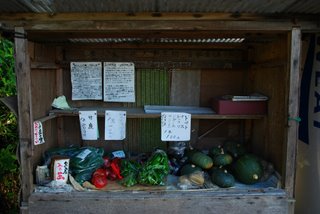 Further down the path was what became a common sight during our cycle around Asuka: a small wooden table set on the gravel with bunches of vegetables and fruit in plastic bags for sale. There was always a nearby tin can of some sort, usually covered in rust with a coin-sized hole at the top for you to drop your money in exchange for your choice of vegetable or fruit. Corn, eggplant, pumpkin squash, carrot, onion, red pepper, cabbage and even grapes were there for the picking. I couldn't name most of the other things left there by the trusting farmer who was no where to be seen. I guess he comes by at the end of the day to pick up what fruit and vegetables are left, and empty out the can of coins. Very trusting, I thought, but that way of thinking is so like a foreigner in this country.
Further down the path was what became a common sight during our cycle around Asuka: a small wooden table set on the gravel with bunches of vegetables and fruit in plastic bags for sale. There was always a nearby tin can of some sort, usually covered in rust with a coin-sized hole at the top for you to drop your money in exchange for your choice of vegetable or fruit. Corn, eggplant, pumpkin squash, carrot, onion, red pepper, cabbage and even grapes were there for the picking. I couldn't name most of the other things left there by the trusting farmer who was no where to be seen. I guess he comes by at the end of the day to pick up what fruit and vegetables are left, and empty out the can of coins. Very trusting, I thought, but that way of thinking is so like a foreigner in this country.
The midday sun was taking its toil. We saw what appeared to be a temple in the distance off the main road and sought it out for some shade. Coming towards it, we realized it was a restaurant not a temple, but thought it was a good time to have a lunch. We each had a bowl of udon. R had hers cold (something I can't do) and I had mine hot with a helping of tempura prawns. There were no other customers. I wasn't sure if this was once a temple, or if was just a glorified farmer's house. It was propped up so that the flooring was almost a metre above the ground. We left our shoes on the steps and sat on the tatami mat to eat. It was completely open to the elements, but I was amazed how cool it was. A soft refreshing breeze blew in between the sliding door panels. I savoured the view of more rice fields and distant hills crowned by lethargic clouds, while sipping on barley tea. The nearby grasshoppers and toads were the only things we could hear.
Ishibutai Area
After passing a few large houses surrounded by rice fields, we entered a small hamlet, which I decided to explore by veering off the main road. There must have been no more than a half-dozen houses here, and I soon found myself facing another rice field. Looming on the left was a "hill" covered in patches of bamboo and thick trees. (I say "hill" but a Japanese would call it a mountain. Having grown up near the Rocky Mountains, I could not call these mere bumps in the land the same word that, to me, describes the tall, impassable towers of rock that surround Banff and Jasper.)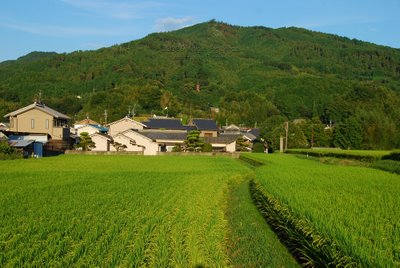
On the hill was something that I had spotted earlier while cycling down the road but which only now really intrigued me. Half-way up , surrounded by trees, was a fiery-hued three-storey pagoda.
Out of nowhere we came upon a small building selling refreshments and a parking lot with a man in uniform directing some cars. That meant only one thing: a major tourist spot. The man told us to park our bikes. We joined a group of other sweaty cyclists in the line for buying drinks or ice cream, then rested in the shade for a few minutes before heading out to see what was the big deal here. The Ishibutai Tumulus is perhaps the most famous spot in Asuka. It amounts to what looks like a pile of boulders on the ground, but is actually a huge sunken chamber. Once you walk around it and then down a steep depression in the ground, you can make your way into a room that is flanked by massive stone boulders on three sides, as well as the ceiling and floor. One might be forgiven for dismissing it as not entirely impressive from an early gance, but given it's reputed age --more than a thousand years -- clearly it is a huge architectural feat. Three things strike me especially. First, the boulders are massive and must weigh a lot. How were they transported? Second, the boulders are placed on top of each other in an almost seamless way. How could people have managed that a thousand years ago? Third, the inner walls, ceiling and roof are almost perfectly flat, creating a real chamber-like feel. How did that come about? Was it natural or were the boulders chiseled?
The Ishibutai Tumulus is perhaps the most famous spot in Asuka. It amounts to what looks like a pile of boulders on the ground, but is actually a huge sunken chamber. Once you walk around it and then down a steep depression in the ground, you can make your way into a room that is flanked by massive stone boulders on three sides, as well as the ceiling and floor. One might be forgiven for dismissing it as not entirely impressive from an early gance, but given it's reputed age --more than a thousand years -- clearly it is a huge architectural feat. Three things strike me especially. First, the boulders are massive and must weigh a lot. How were they transported? Second, the boulders are placed on top of each other in an almost seamless way. How could people have managed that a thousand years ago? Third, the inner walls, ceiling and roof are almost perfectly flat, creating a real chamber-like feel. How did that come about? Was it natural or were the boulders chiseled?
It is very interesting how this presents more questions. In Europe, from the time of the Romans a common building material was stone. Wooden buildings were certainly constructed but anything of importance was built in stone. In Japan, the opposite occured. Stone buildings, to my knowledge, were practically non-existent; wood was the norm, with buildings that were perhaps susceptible to fire but otherwise managed to stay around for many centuries, much like their counterparts in Europe. And yet here in Asuka, there were these boulders which were obviously a sign of a civilisation that had expert use of stone, although these apparent tombs had no signs of masonry. Why then did these boulders come to be here; why is it that Asuka seems to be an anomaly and there aren't other parts of Japan with similar boulders; and why, with this apparent foray into using stones for building did this civilisation not develop masonry skills like in the West?
There were other tumuli in the area but R and I didn't get a chance to see them. After Ishibutai, we consulted our map and decided to find out how to get to that pagoda half-way up the hill I had seen earlier. According to the map it was Okadera Temple. We followed a narrow road that began winding around crops of trees and small rice fields, gradually rising up the hill. Soon the angle became too steep and we dismounted from our bicycles and began pushing them up the hill. The sun was beating down our backs, my shirt was soaked in sweat. I was beginning to think a bicycle was not a good idea. According to the map there was a very steep grade coming soon. (There was even a character drawn on the map, along the path that we were on, obviously struggling and sweating, with the words "Very tough going!" written beside him).
We followed a narrow road that began winding around crops of trees and small rice fields, gradually rising up the hill. Soon the angle became too steep and we dismounted from our bicycles and began pushing them up the hill. The sun was beating down our backs, my shirt was soaked in sweat. I was beginning to think a bicycle was not a good idea. According to the map there was a very steep grade coming soon. (There was even a character drawn on the map, along the path that we were on, obviously struggling and sweating, with the words "Very tough going!" written beside him).
We came upon a sunburnt man with a wrinkly face who was doing some woodwork in a shed beside the road. Below his shed were terraces of rice fields. The path further along disappeared under a tunnel of thick bamboo.
R stopped to talk to the man while I took a picture of the rice fields. (For some reason I had been struggling all day to get a picture of a rice field that could satisfy me. I don't know why I felt obsessed by it; what was there in these green stalks that were so hard to give an accurate exposure reading? All my shots looked under-exposed and washed out whenever I checked the LCD panel)
R came over to report that the man, while talking her ear off had announced we were fools to go up the path on bicycles. We would be better off following the narrow gravel path that went from his shed down the hill where it joined a main road we could take to a parking lot that eventually led to the temple. Down the path I sped, any feelings of regret for having got so far for nothing dispelled by the utterly rapturous breeze of air that sang by my ears and cooled my sweaty shoulders. We made it to the parking lot shortly after and parked our bikes, then starting climbing some stairs that led up a steep slope. At the top we turned left and before us was the temple gate. The late-afternoon sun was shining through the branches overhead. The light that fell on the orange-coloured, two-storey gate was divine.
Down the path I sped, any feelings of regret for having got so far for nothing dispelled by the utterly rapturous breeze of air that sang by my ears and cooled my sweaty shoulders. We made it to the parking lot shortly after and parked our bikes, then starting climbing some stairs that led up a steep slope. At the top we turned left and before us was the temple gate. The late-afternoon sun was shining through the branches overhead. The light that fell on the orange-coloured, two-storey gate was divine.
We paid the entrance fee to the man who received us through a small window, then went through the gate, climbing more steps that wound up the mountain. Did I say mountain? Well it was certainly starting to feel like one now. At the top, one path led over to the main temple area while another swung around to the pagoda I had seen before. R went up ahead while I was distracted by some flowers (a great chance to try out the macro setting on my camera) but I soon heard her calling to me, saying "What a nice view!"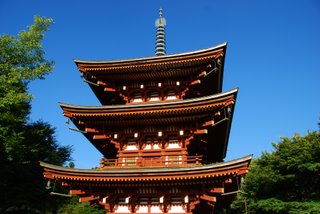 I went after her, found her in front of the pagoda, and took in the view. Below us were the tops of trees, ending half-way down the slope, at which point the terraced rice fields began. In the distance were more hills and above it the sun making striking shapes with its rays cutting through the clouds. In between the distant hills and nearby rice fields was a busy landscape. The ground was uneven, and over it, managing anyway they could stood hamlets here and there, isolated buildings like large farmers' houses, more rice fields, and the main road that snaked around them all.
I went after her, found her in front of the pagoda, and took in the view. Below us were the tops of trees, ending half-way down the slope, at which point the terraced rice fields began. In the distance were more hills and above it the sun making striking shapes with its rays cutting through the clouds. In between the distant hills and nearby rice fields was a busy landscape. The ground was uneven, and over it, managing anyway they could stood hamlets here and there, isolated buildings like large farmers' houses, more rice fields, and the main road that snaked around them all.
I felt tired from the climb but invigorated from the view. The whole landscape in front of me seemed alive. There was a sense of energy and agelessness all about us. We stayed around for about an hour and then started our journey back to the station. It was already five o'clock, the time our rental bikes were due, but the old lady had said that if we came late we could just leave the bikes in front of her shop, so there was no hurry.
There were a few long slopes along the way, and I found it a real treat to be racing down the opposite side with the cool air bracing my whole body. R seemed to apply her brakes a lot, so I had to stop and wait for her to catch up. We followed the main road back to the station, passing all the places we had come across earlier, but now things had a different light about them in the late afternoon sun, so I stopped often to re-take a shot.
It was just before the last stream when suddenly my eye caught something: a vertical banner in the Japanese style with large katakana characters in purple: WINE. It was adorned with a drawing of fat purple grapes. There was an arrow pointing down a street that followed the stream, and flanked by --what else-- rice fields. It wasn't an even or straight road. We followed it as it winded its way beside the stream while the rice fields gave way to greenhouses and brown patches of soil studded with vines.
Just as the road reached the beginnings of another hamlet, we realized we had hit our destination. On the left was a similar looking sign to the one that had caught me before. We stopped and walked in the large garage that served as a store for the aptly named ASUKA WINE. A few generous tastings and a lively conversation later (with the very friendly owner), we walked back out with two bottles, one a Kyohou (similar to a Rose), and a medium Red.
A few generous tastings and a lively conversation later (with the very friendly owner), we walked back out with two bottles, one a Kyohou (similar to a Rose), and a medium Red.
I had never thought I would come across a winery so near to Osaka. I thought one day I would make it to Kofu to visit the a Japanese vineyard there. But this little trip to Asuka had turned into a real treat. I am sure to go back soon. All along the way back to Osaka on the train, I thought about making a new website for the winery owner who had said he doesn't care much about his website. All in return for say, a dozen bottles of Asuka wine.
Posted by
an-fi (Angel Figueroa)
at
10:19 PM
1 comments
![]()
Labels: an-fi gallery, flowers, hiking, Japan, Kansai, landscapes, nature, rural, shrines/temples, sky, summer, travelogue






